Mosquito Spray: Collateral Damage to Pollinators and Human Health
By Amanda Serra
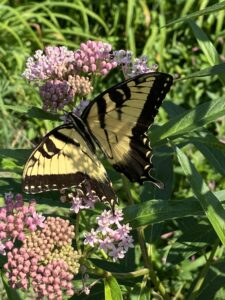 My sister had a butterfly garden in her backyard for many years. Every summer, hundreds of Monarchs, Swallowtails, American and Painted Lady, Red Admiral, and Viceroy visited her yard to feed, reproduce, lay eggs, undergo metamorphosis, pollinate flowers and repeat the cycle year after year. Unfortunately, about three years ago the butterflies stopped coming.
My sister had a butterfly garden in her backyard for many years. Every summer, hundreds of Monarchs, Swallowtails, American and Painted Lady, Red Admiral, and Viceroy visited her yard to feed, reproduce, lay eggs, undergo metamorphosis, pollinate flowers and repeat the cycle year after year. Unfortunately, about three years ago the butterflies stopped coming.
Not one butterfly for three years.
Finally, my sister gave up and removed her butterfly garden. There didn’t seem to be a point to it anymore.
What is going on?!
I’m a chemistry teacher by day, a microbiologist by education, and a beekeeper by hobby. It didn’t take much investigation to find the answer to this question.
Mosquito sprays.
Pyrethroids and/or its derivatives (bifenthrin, deltamethrin, cypermethrin, and permethrin) are commonly used by mosquito exterminators, but any pesticide can kill butterflies and bees, as well as other beneficial insects. If not killed outright, a bee can carry the residue to the hive where it is incorporated into the wax and honey, causing disruptions in behavior and colony collapse. (Pyrethroids and Nectar Toxins Have Subtle Effects on the Motor Function, Grooming and Wing Fanning Behaviour of Honeybees)
To add insult to injury, pollinators aren’t the only victims of pyrethroid use. ALL pyrethroids are toxic to humans and pets. (Pyrethroid Poisoning;
Pyrethroids: How They Affect Human and Animal Health? Current Research on the Safety of Pyrethroids Used as Insecticides)
The Solution – Mosquito Dunks
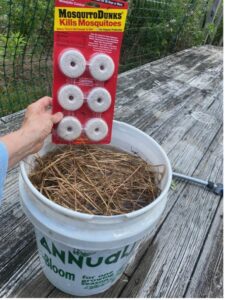 There is an easy, inexpensive and non-toxic method to reduce the mosquito population in your yard. Bacillus thuringiensis israelensis (Bti), a common soil and water bacteria, contains toxin-packed spores that kill mosquito, blackfly and fungal gnat larvae. Spores within the bacteria kill the larvae within a day. (X-ray imaging reveals insights into a natural mosquito-killing compound). The toxins are specific for mosquito and blackfly larvae and will not harm beneficial insects, pets or humans if consumed. What you need to know about Bit; Bacterial Toxins Active against Mosquitoes: Mode of Action and Resistance)
There is an easy, inexpensive and non-toxic method to reduce the mosquito population in your yard. Bacillus thuringiensis israelensis (Bti), a common soil and water bacteria, contains toxin-packed spores that kill mosquito, blackfly and fungal gnat larvae. Spores within the bacteria kill the larvae within a day. (X-ray imaging reveals insights into a natural mosquito-killing compound). The toxins are specific for mosquito and blackfly larvae and will not harm beneficial insects, pets or humans if consumed. What you need to know about Bit; Bacterial Toxins Active against Mosquitoes: Mode of Action and Resistance)
Benefits
Inexpensive – Can be purchased at Lowe’s, Home Depot, Walmart and online home and garden supply vendors for $8.50 – 10.00 for a pack of 6 dunks. One small donut-shaped Mosquito Dunk in a bucket of water kills 90 – 100% of mosquito larvae. (Effects of mosquito control using the microbial agent Bacillus thuringiensis israelensis on aquatic and terrestrial ecosystems: a systematic review)
Easy homeowner application: treat from approximately April to October
(The best way to kill mosquitoes – instead of fogging; How to set up a mosquito larvae trap)
Place straw/hay in a bucket.
Add water.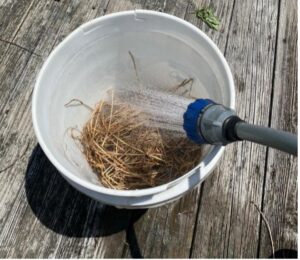
Put bucket in a sunny place for two days to ferment.
Then place bucket wherever mosquitoes congregate.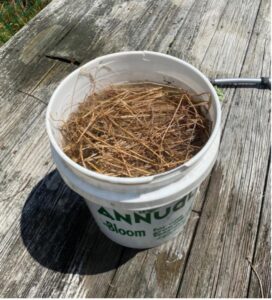
Drop a Mosquito Dunk in the bucket.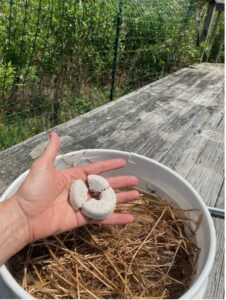
Approximately one quarter chunk of a dunk/month for a 5 gallon bucket.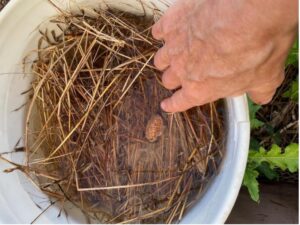
Female mosquito is drawn to fermented mix and lays eggs. Throw in another dunk approximately 30 days later. Stop use when weather cools
We CAN reduce toxic loads in our environment and rebuild the pollinator population by considering effective, non-toxic, and inexpensive alternatives to controlling/killing mosquitoes in several ways.
- Remove standing/stagnant water around property.
- Set up mosquito traps: bucket of water with straw in it and Mosquito Dunk.
- Use Mosquito Dunks in rain barrels, bird baths, water gardens.
- Plant mosquito repellent plants: Lavender, Marigold, Citronella/(Lemon Grass), Catmint, Rosemary, Basil, Citronella/Scented Geranium, Bee Balm, mint, Floss Flower, Sage, and Allium
- Encourage local businesses, and fellow citizens to contact their city council to make their community a Bee City. https://beecityusa.org/benefits/
Addendum: Neonicotinoids: just as bad, or even worse than pyrethroids? https://www.nrdc.org/stories/neonicotinoids-101-effects-humans-and-bees
https://www.sciencedirect.com/topics/agricultural-and-biological-sciences/neonicotinoid


